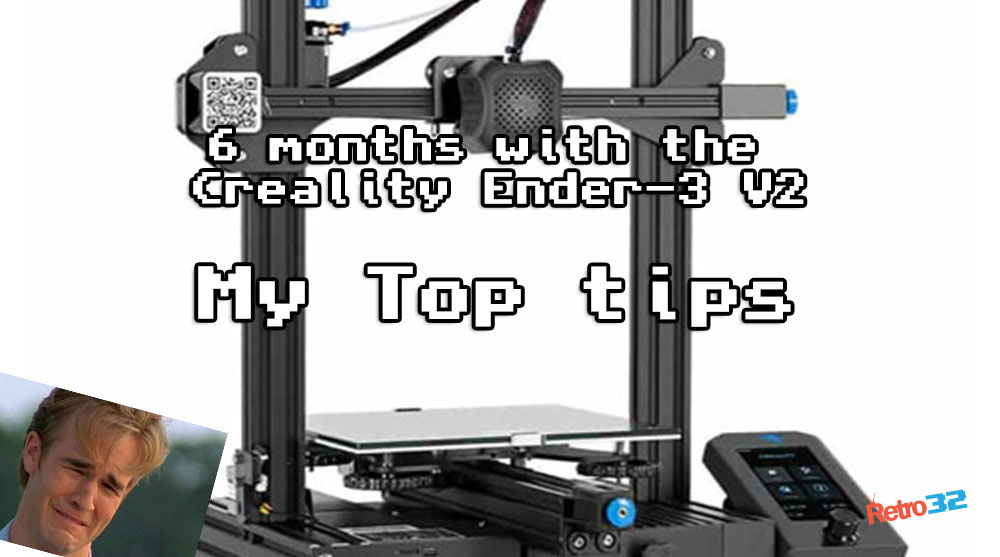After 6 months with not one but two Creality Ender-3 V2 3D printers, I’ve come to the realisation that if all else fails. LEVEL. YOUR. BED.
What started out as a way to fill those long lockdown evenings quickly became both one of the most frustrating and rewarding hobbies that I’ve ever regretted getting into, I’m also very glad I did. I’ve learned new skills, gained patience, and quickly discovered that I should never underestimate my own stupidy. I’ve lost my temper, thrown things across the room, burnt my fingers, wasted money, bled and come close to tears with frustration. Welcome to 3D Printing.
I’m not here to teach you to suck eggs, or pretend I’m an expert, this article is about my experiences with the Ender-3 V2. It’s about what I’ve learned, it’s about me leveling the bed until my knees were sore. Hopefully, you’ll learn a little from my battles and stop asking for help on Ender 3 Facebook groups when all you need to do is Level the f**kin bed.
In no particular order here are my top tips and experiences with the Creality Ender-3 V2
Don’t buy from Creality direct
I’ve read many frustratied posts from my fellow owners after buying from Creality direct. Long lead times, poor (if any) customer service, and an overall bad experience. Buy from a trusted seller in your own country if possible, maybe even try Amazon. If things do go wrong then you’ll sleep well knowing you’ll at least get your money back. My first 3D Printer came from Box UK but the second from Amazon. The second machine was plagued with issues and ultimately went back. I replaced it with another from Box and it has been perfect. I can’t speak about their customer service but delivery was prompt and their prices were great. This isn’t an avert for Box, just highlighting the need to buy local and from a trusted and established company. If you’ve had experiences – good or bad then please let us know in the comments.
Look after your filament
I’ve been through countless rolls of filament with 95% of it coming from Amazon. During the first lockdown, PLA seemed to be in short supply so I took anything I could. Apart from issues caused by my own stupidity, I’ve never had any issues with different brands but I must stress that you need to store your filament correctly. You know that vac sealed bag and little packet of moisture/silica beads?? Keep it. If you’re going to stop printing for more than a few days then bag it up and do everything you can you keep it moisture-free. Don’t leave it on the floor or just sat on the side, pop it back in the bag and make sure the silica packet is in there. If you have a plastic tub with a lid then pop all your rolls in there and keep the devil’s perspiration away. It’ll cause clogs, weak prints, and headaches. For anyone interested – I print with a hotend at 210c – that seems to work for me.
If your PLA has suffered at the hands of the moisture monster then pop it in the oven at 60c for 30 mins to dry it out and pop it back in the bag. If that fails then bin it. You can also use a filament dehydrator – I’ve never used one but maybe you’re feeling flush.
Upgrades
So you’ve ordered your first printer, joined the Ender 3 Facebook groups, now what? Rather than watch all those very useful videos on how to correctly assemble your printer safely – you look at upgrades before you’ve even taken delivery of it. WRONG. Learn the machine, love the machine. Buy it flowers, caress it, touch it and learn it’s many flaws (and your own). When you truly understand it you will know what needs upgrading. It’s true that many owners have never upgraded their v2s, I’m not in that camp but I’ve understood what would benefit me rather than replace so many components only a printer I don’t fully understand making fault-finding an issue near impossible.
- Bed Clips
Out of the factory the v2 bed is clipped in the center – front and back. In my case, this made leveling “interesting”. Using four bulldog clips helped create a level and evenly attached bed. It was also damn cheap and really did make a difference to consistent leveling.
- Silicon bed mounts
Upgraded bed springs / Silicon bed mount are usually the first things people suggest when you’re having to relevel your bed after every print. They provide increased bed tension and stop the bed from losing its level (apparently). You can use the stock springs but remember to wind them quite tight and adjust your Z stop switch accordingly. I’m using silicone on both my v2s and it’s helped… I think.
- BLT – BL Touch
BL Touch is hands down the best upgrade I’ve made to my Creality Ender 3 v2. This little sensor allows the printer to adjust itself for my bed leveling “inconsistencies”, meaning I level less and print more. Leveling has reduced from after every print to once a fortnight (if needed at all!). However, I must warn you to be careful. My bed has the battle scars to prove that you MUST understand how it works and how to set it up. The Z offset is the key but also is having a stable and level bed to begin with. If you’re using upgraded bed clips and Silicon bed mounts it will help – so too with the mesh leveling in Octo Print but we’ll get to that later. Just remember that BLT is an aid to getting your bed level. If you get it nearly perfect then you’ll be golden. Remember to add G29 ; to your gcode to run a level before every print – it’s worth the extra 20 seconds of your time.
- OctoPrint – Remote Printing
Connecting your Printer to your home network using a Raspberry Pi running OctoPrint has saved me incomprehensible amounts of time. Loading that bloody SD card, trying to push it in the wrong way, then the pure anger when the supplied crappy SD card fails and you’ve not backed up your gcodes. It’s something I strongly suggest for every 3d printing enthusiast. Having your 3 Printer connected using OctiPrint means you can kick off prints whilst on the toilet, sat on the sofa or even having a beer in the garden. Yes, it’s brave to not witness your first layer but if your BLT is finely tuned and you’re all “YOLO” then why not. For those with voyeuristic tendencies, you can also connect a camera and remote view that first layer p0rn. You dirty boy!
OctoPrint also allows 3rd party plugins that can assist you with settling up your printer and add new features. The bed visualiser plugin allowed me to get my bed nearly perfect before I let the BLT do it’s thing. It creates a visual representation of how level your bed is, allowing you to make fine adjustments and dial it in near perfectly.
With the upgrades out the way here are some quick first tips that I’ve found useful.
Clean the nozzle when changing the filament
Here’s my process when I change over to a new roll of PLA. Preheat the printer – wind the temp up to 250c – when it’s at temperature carefully wind the PLA back out using the extruder knob (don’t rush it with the release lever) – with the PLA unloaded and the nozzle at 250 use the supplied nozzle cleaning needle and give it a damn good poke. Please be careful, I’ve burnt my finger and also poked myself with that bloody needle. Both were not experiences I wished I wished to repeat. Spoiler: They did.
Cleaning your nozzle will help reduce cogs. Cogs aren’t fun, they result in banding and brittle/soft prints.
Learn how to use Tinkercad / Fusion 360
Whilst Thingiverse is a great resource for “pre-made” models NOTHING compares to printing something you’ve designed yourself. Buy yourself and micrometer and enjoy. Tinkercad is great for a beginner but Fusion 360 is really where it’s at. There are a huge number of video tutorials – I would highly recommend Lars Christensen’s channel – he’s a legend!
Don’t tell friend or family you have a 3D printer
The conversation usually begins. “So… I hear you have a 3D printer”. It usually continues with them asking you to make something that they could buy for £1.99 on eBay and you’ll spend a week going back and forth with prototypes until you perfect the design or you’ll get dragged into trying to help them with 3D printing basics and troubleshooting. Don’t tell anyone you have it, print stuff, make stuff, and enjoy it, You’ll need all the enjoyment from you can because when it turns into a spaghetti machine for a week and wastes half a roll of filament on an overnight print then you’ll at least remember the good times.
Use Smart Plugs
Smart plugs not only let you command Alexa to “Turn on 3D Printer Number fu**ing one the stupid b@5t*** F?>>er” and also allows you to schedule your printer to turn off after a set period or at a certain time. This keeps energy costs down and also means you can go to bed knowing that the chances of a housefire are somewhat reduced. – That’s a joke. I hope.
Get a second printer
So you’ve got a printer and you’ve had a silly idea of selling stuff you’re printing. Do yourself a favor and buy a second one. If the first one is “down” for any reason then you not only have a backup but you have spares. There’s nothing worse than selling something and having your printer breakdown after your customer has already handed over the cash. It also gives you the chance to develop new products to sell whilst your first is printing money.
Clean your bed
Cleaning your bed with 100% isopropyl means that you’ll have a shiny surface free of any oils, muck, or any other questionable substance giving you the best chance of your print staying in one place. I personally use a little 100ml spray bottle full of 100% isopropyl and a microfiber towel. I clean the bed before EVERY print. You should too.
And finally
LEVEL. YOUR. BED.
So your prints aren’t sticking to the bed?
Your extruder is clicking (and it’s not a clog)
Your prints are getting 3 hours in and popping off – inviting the spaghetti monster to play.
Your prints are warping at the edges
Your prints have a scratched first layer with holes
You need to LEVEL. YOUR. BED – then level it again, then again and once you’ve done that maybe once (or twice for luck). Then before you go bleating on a 3D printing facebook group about any of the above – level that ****ing bed again. Trust me – people are fed up with telling all the 3D printing “beginners” the same thing. We’ve all been there but please please listen. LEVEL IT.
You shouldn’t need to use glue or grab tape for your prints to stick. Just level your bed. If you can’t level your bed manually then don’t buy a BLT. Learn the basics.
I use a bed leveling gcode that probes all four corners plus the center. Use a bit of paper and get the nozzle so it catches but doesn’t rip it. If you’re unsure then check out one of the 1000 YouTube videos that cover it. Do it. Please just for me.
Here is the gcode I use
Let’s hear from you
Like I said at the beginning of this article, I’m not an expert – far from it but I’ve been doing it long enough, said f***!!! enough times, cried myself to sleep and hurt myself enough times to have kind of worked out what works for me. If there’s something I’ve missed or something I’ve got wrong then please do let me know in the comments below or maybe even send me an email, tweet me, message me on Facebook or whatever. I’m just trying to help and I wish I had read something like this when I was new to 3D Printing.
3D Printing isn’t for everyone. Like Karen says: Live, Laugh, Love and Level your bed.
If you like what you read then consider using our links to buy stuff – maybe even treat yourself to one of our epic mugs.


